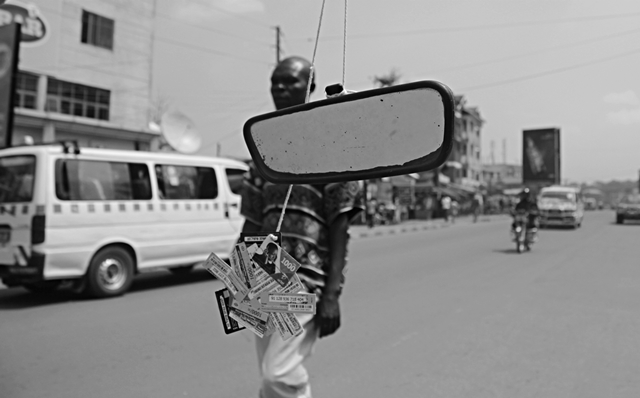The aesthetics of photography, like the harmoniously pleasing and evocative sound of music, and the intense rhythmic expression in poetry engages with and narrates our world over. In an imaginative form, through their unique lenses, the expressionists of this medium translate and act their creative parts. A form, more often than not, that awakens our senses and inspires us to (re)imagine and (re)interpret; encouraging us to observe, explore, and further examine the world we live in.
Photography can be considered a performance of still images in time and space, taking on the identity of its subject(s). Its power, within its aesthetical and historical lens, is its “direct route to a long-term memory”; reconstructed or otherwise, each image storing its own information as a coherent concept. Serubiri Moses, a Ugandan writer-photographer-musician’s recent black and white photographic series takes us on an aesthetical journey on what is an expression and subtle critique of Uganda’s material culture, emblematic of capitalism in a post-colonial space.

Through a reconstructive creative process of “real time experience”, juxtaposing identifiable objects his series evokes and provokes questions regarding the construct of cultural history, the appropriation of identity –possessions in a post-colonial era, perhaps transported from colonialism– and conflict space(s) within the context of his environment. To Serubiri, “Space is a recurrent theme, particularly, how space works.”
His work, I find, offers a profound story, in what feels like objects traveling through a wide and open space, almost dream-like (serene) and at the same suggestive of some sort of turbulence. The entire motif takes on a deliberate position to detail and mark the significance of foreign objects and anachronistic mediums, within a cultural historical context.
In a recent conversation with Serubiri, we had an opportunity to learn about his multifaceted artistry and the meaning behind his poetical photography “car series”. Observantly representational of the interface between space and identity, his work attempts to “peel the layers” to get to the primal source of (living) things. “The car series deals with personal space, placing that personal space in the public” he explains, furthermore, “I think of notions of space conflict within discourses of identity. This is a subject that I am currently exploring in my writing, too.”

On the aesthetics and motif of the series:
“I reconstructed the car using the rear-view mirror and the pendant hanging from it. The series deals with the familiar or normal object(s) of the car. It is the norm that every middle class person in Uganda aspires to owning a car. I had been writing an essay on the car as a metaphor for postcolonial experience, and ended up discussing the functioning of class in Uganda from the perspective of bourgeois aggression. Their insulation from the lower class in big houses and mansions uphill is implied in the series.”
“The various layering that occurs comes from the spontaneity of my poetic process. That you can look at one thing and arrive at another and another all in the same frame, that there is not a directly logical connection between the objects in the viewfinder: they are, somehow, poetically related.”
On objects as symbolism:
“The mask is a controversial object within art history. In Uganda, it is simply a commodity from the Congo because Ugandan societies are not mask-makers. So, the mask is also foreign in their view.”
On narratives and the implicit/explicit expression(s):
“Narratives are certainly part of my photographs. I’m concerned with the story of objects or things in relation to history and politics. Showing them interests me, so the story is also what happens when people see it. ” As for the expression, “The implicit, perhaps, reflects my cultural context. Ganda (Uganda) expression is mostly implied. The explicit is an aesthetic quality.”
Not to be confused, far from using his art to vigorously campaign for social change, Moses emphasizes: “In fact, my work has more to do with the aesthetics of living than the politics of living. I am aiming at the viewer and provoking their laughter or their feelings towards certain objects.” Further noting, “I am never cautiously posing questions suggestively, as advertising does, or interrogating discourses with my artwork as particular Afro-modernist works do. I am simply navigating the world in which I live, so the objects are part of that navigation: these are objects within my environment, and the humor that comes along with them inspires me.”
Moses hopes, inside the realm of African artistic expression that his photographs can add to images outside of the conventional ones coming out of Uganda, and Africa in general.
To learn more about Serubiri Moses’ work please connect with him on: (http://www.facebook.com/serubiri.moses)







